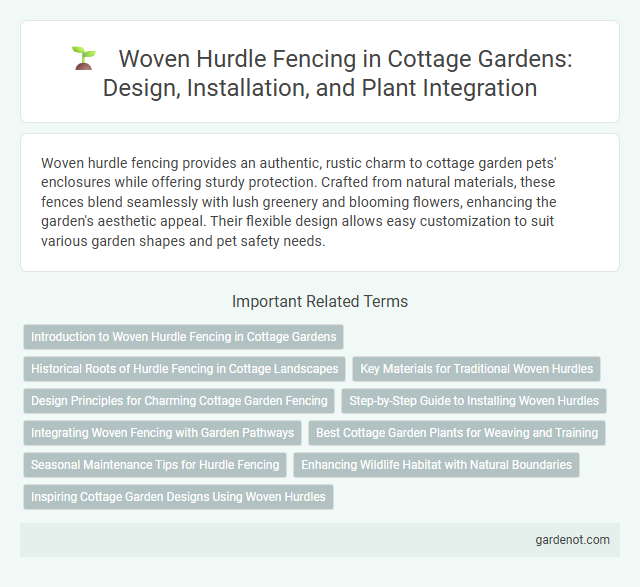Woven hurdle fencing provides an authentic, rustic charm to cottage garden pets' enclosures while offering sturdy protection. Crafted from natural materials, these fences blend seamlessly with lush greenery and blooming flowers, enhancing the garden's aesthetic appeal. Their flexible design allows easy customization to suit various garden shapes and pet safety needs.
Introduction to Woven Hurdle Fencing in Cottage Gardens
Woven hurdle fencing is a traditional and eco-friendly boundary option commonly used in cottage gardens, crafted by interlacing flexible hazel or willow rods to create natural panels. This type of fencing enhances the rustic charm while providing a durable, breathable barrier for garden beds and pathways. The organic textures and patterns of woven hurdles promote wildlife habitats and blend seamlessly with perennial borders and climbing plants.
Historical Roots of Hurdle Fencing in Cottage Landscapes
Woven hurdle fencing has ancient origins dating back to Neolithic times, when early communities used hazel and willow rods to create durable, flexible barriers. In cottage gardens, these fences provided cost-effective, sustainable enclosures that harmonized with rural landscapes and supported local ecosystems. Their traditional craftsmanship remains valued for aesthetic authenticity and ecological benefits in modern garden designs.
Key Materials for Traditional Woven Hurdles
Traditional woven hurdle fencing primarily utilizes hazel, willow, and sometimes sweet chestnut branches for their flexibility and durability. Hazel is favored for its strength and ease of weaving, while willow offers resilience against weather and quick regrowth for sustainable harvesting. Sweet chestnut, known for its hardness and natural rot resistance, adds longevity to the hurdle structure, making these materials essential for authentic cottage garden fencing.
Design Principles for Charming Cottage Garden Fencing
Woven hurdle fencing enhances cottage gardens by combining natural materials like hazel or willow with traditional craftsmanship, creating a rustic yet elegant boundary. The design principles emphasize organic textures, irregular patterns, and low heights to maintain openness and complement the informal planting style typical of cottage gardens. Incorporating these elements results in fencing that blends seamlessly with lush flower beds, enhancing the garden's enchanting and inviting atmosphere.
Step-by-Step Guide to Installing Woven Hurdles
Woven hurdle fencing offers a charming and eco-friendly boundary option for cottage gardens, crafted from natural materials like hazel or willow rods. Begin by preparing the fence posts, ensuring they are firmly set in the ground at equal intervals; then proceed to weave the flexible rods horizontally through the upright stakes, starting at the bottom and working upwards for a tight, secure fit. Secure the ends of the rods with garden twine or small nails to maintain stability, and finish by trimming any excess material to create a neat, rustic barrier.
Integrating Woven Fencing with Garden Pathways
Woven hurdle fencing creates a natural boundary that seamlessly guides garden pathways, enhancing the rustic charm of a cottage garden. The interlaced hazel or willow branches provide both structural support and aesthetic continuity, blending with surrounding plants and flowers. Integrating these fences along pathways defines the route while maintaining an open, inviting atmosphere throughout the garden.
Best Cottage Garden Plants for Weaving and Training
Woven hurdle fencing blends rustic charm with functionality, ideal for supporting climbing cottage garden plants like sweet peas, clematis, and honeysuckle. These vigorous climbers easily weave through the interlaced branches, creating vibrant, fragrant screens that enhance garden privacy. Selecting flexible species such as willow or hazel for the hurdles improves durability and complements the natural aesthetic of traditional cottage gardens.
Seasonal Maintenance Tips for Hurdle Fencing
Woven hurdle fencing in cottage gardens requires seasonal maintenance to preserve its durability and aesthetic appeal. Regularly inspect for broken or loose twigs, repairing them promptly to prevent structural damage, and apply a protective wood preservative in early spring to guard against moisture and rot. Clearing debris and ensuring good air circulation around the fencing during wet seasons reduces mold growth and extends the lifespan of your woven hurdles.
Enhancing Wildlife Habitat with Natural Boundaries
Woven hurdle fencing creates natural boundaries that provide essential shelter and nesting sites for birds, insects, and small mammals within a cottage garden. This traditional fencing method uses interlaced hazel or willow branches, promoting biodiversity by mimicking natural hedgerows and supporting pollinators like bees and butterflies. Incorporating woven hurdles enriches wildlife habitat while maintaining an eco-friendly, rustic aesthetic.
Inspiring Cottage Garden Designs Using Woven Hurdles
Woven hurdle fencing brings a rustic charm and natural texture to cottage gardens, perfectly complementing traditional planting schemes with flowering perennials and climbing roses. Crafted from flexible hazel or willow rods, these hurdles create eco-friendly boundaries that enhance garden aesthetics while supporting biodiversity. Incorporating woven hurdles in cottage garden designs encourages a harmonious blend of structure and softness, inspiring timeless outdoor spaces full of warmth and character.
Woven hurdle fencing Infographic

 gardenot.com
gardenot.com